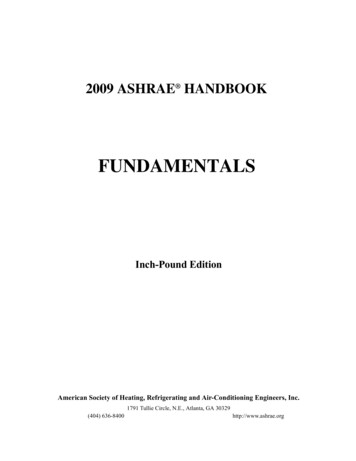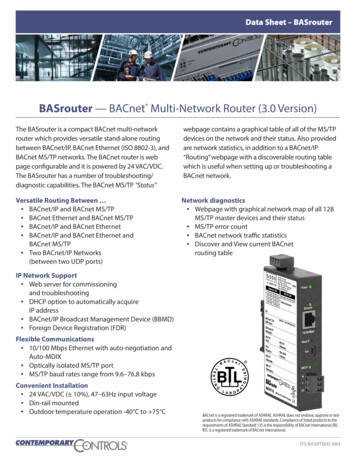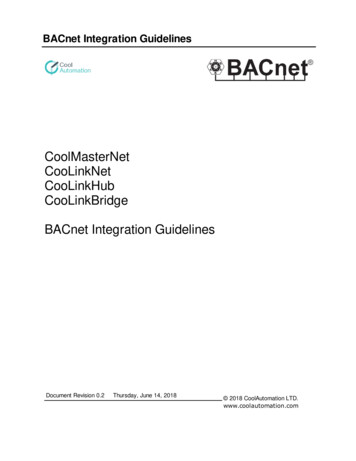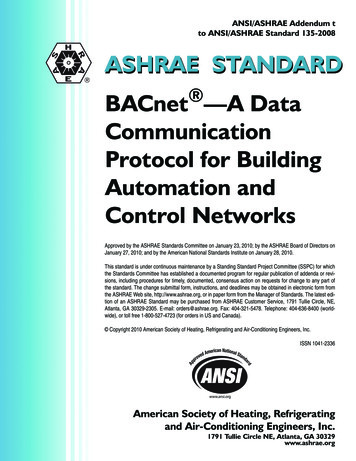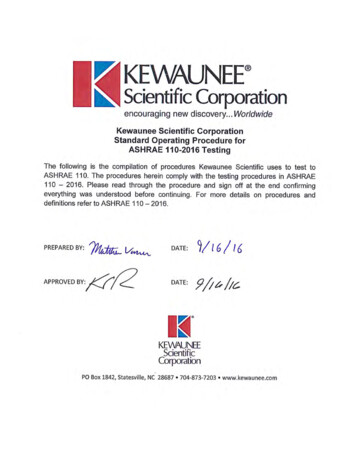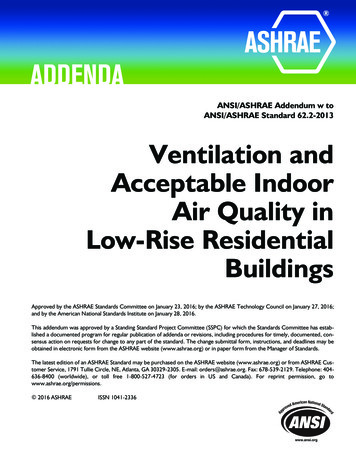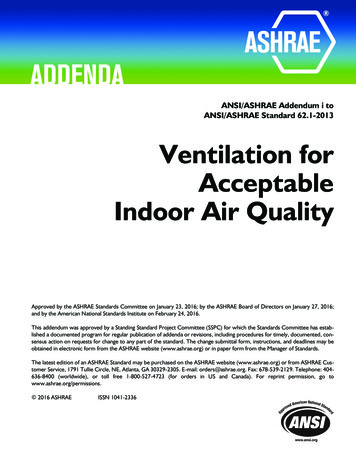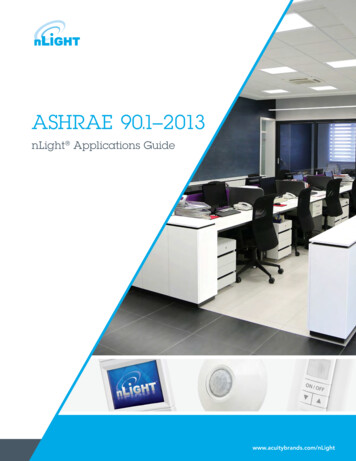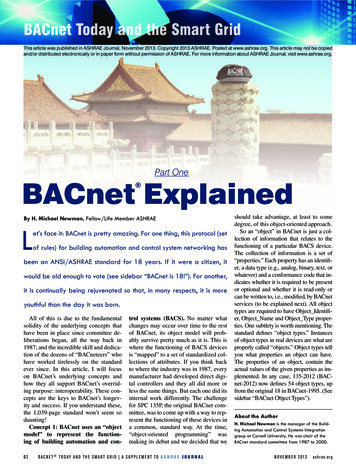
Transcription
BACnet Today and the Smart GridThis article was published in ASHRAE Journal, November 2013. Copyright 2013 ASHRAE. Posted at www.ashrae.org. This article may not be copiedand/or distributed electronically or in paper form without permission of ASHRAE. For more information about ASHRAE Journal, visit www.ashrae.org.Part OneBACnet Explained By H. Michael Newman, Fellow/Life Member ASHRAELet’s face it: BACnet is pretty amazing. For one thing, this protocol (setof rules) for building automation and control system networking hasbeen an ANSI/ASHRAE standard for 18 years. If it were a citizen, itwould be old enough to vote (see sidebar “BACnet is 18!”). For another,it is continually being rejuvenated so that, in many respects, it is moreyouthful than the day it was born.All of this is due to the fundamentalsolidity of the underlying concepts thathave been in place since committee deliberations began, all the way back in1987; and the incredible skill and dedication of the dozens of “BACneteers” whohave worked tirelessly on the standardever since. In this article, I will focuson BACnet’s underlying concepts andhow they all support BACnet’s overriding purpose: interoperability. These concepts are the keys to BACnet’s longevity and success. If you understand these,the 1,039-page standard won’t seem sodaunting!Concept 1: BACnet uses an “objectmodel” to represent the functioning of building automation and conB2trol systems (BACS). No matter whatchanges may occur over time to the restof BACnet, its object model will probably survive pretty much as it is. This iswhere the functioning of BACS devicesis “mapped” to a set of standardized collections of attributes. If you think backto where the industry was in 1987, everymanufacturer had developed direct digital controllers and they all did more orless the same things. But each one did itsinternal work differently. The challengefor SPC 135P, the original BACnet committee, was to come up with a way to represent the functioning of these devices ina common, standard way. At the time,“object-oriented programming” wasmaking its debut and we decided that weB A C N E T T O D AY A N D T H E S M A RT G R I D A S U P P L E M E N T T O A S H R A E J O U R N A Lshould take advantage, at least to somedegree, of this object-oriented approach.So an “object” in BACnet is just a collection of information that relates to thefunctioning of a particular BACS device.The collection of information is a set of“properties.” Each property has an identifier, a data type (e.g., analog, binary, text, orwhatever) and a conformance code that indicates whether it is required to be presentor optional and whether it is read-only orcan be written to, i.e., modified, by BACnetservices (to be explained next). All objecttypes are required to have Object Identifier, Object Name and Object Type properties. One subtlety is worth mentioning. Thestandard defines “object types.” Instancesof object types in real devices are what areproperly called “objects.” Object types tellyou what properties an object can have.The properties of an object, contain theactual values of the given properties as implemented. In any case, 135-2012 (BACnet-2012) now defines 54 object types, upfrom the original 18 in BACnet-1995. (Seesidebar “BACnet Object Types”).About the AuthorH. Michael Newman is the manager of the Building Automation and Control Systems Integrationgroup at Cornell University. He was chair of theBACnet standard committee from 1987 to 2000.N OVEM BER 2013ashrae.org
BACnet is 18!Believe it or not, BACnet has been a standard for 18years. Here is a timeline of some of the most importantevents in its history: 1987 – First meeting of SPC 135P, the “EnergyMonitoring Control Systems Message Protocol”committee, in Nashville, Tennessee. 1990 – Project name is officially changed to “BACnet.” 1991 – First public review begins. 1995 – After three public reviews and 741 comments from 81 commenters in 11 countries, BACnetis finally approved and published as an ANSI/ASHRAE standard (135-1995). It is a petite document of a mere 501 pages. 1996 – Standing SPC 135 is formed. BACnet becomes one of the first standards to be maintainedunder new “continuous maintenance” procedures. 1998 – First BACnet Interest Group, BIG-Europe(BIG-EU), launches in Frankfurt, Germany. BACnetwebsite, www.bacnet.org, goes online. 1999 – BACnet/IP, the first addendum to BACnet-1995 is approved. BIG-North America (BIGNA) is formed and BACnet becomes a Koreannational standard. Engineering News-Recordmagazine selects BACnet as one of the “Top 125Innovations of the Last 125 Years.” 2000 – The BACnet Manufacturers’ Association(BMA) is formed and soon opens the BACnet Testing Laboratory. BACnet is translated into Chineseand Japanese. BMA sponsors first BACnet Interoperability Workshop (“PlugFest”) at NIST with 12organizations attending. (PlugFest-2012 had 49teams.) 2001 – The second consolidated version of theObjects solve the problem of representing the functions of agiven BACnet device in a standard, network-visible way. Eachobject is uniquely identified within the device that maintains itby its Object Identifier property. The combination of a uniqueinternetwork-wide object identifier for the device and a uniqueobject identifier within the device for each object allows theobject to be unambiguously accessed or “addressed” over thenetwork. Knowing the possible “property identifiers” for eachobject allows the value of the property to read and, possibly,written. The collection of a set of objects is called a “BACnetDevice.”The object model was designed to be flexible and extensible.This allows new objects, both standard and proprietary, to bedeveloped with ease, a concept that has stood the test of time!Concept 2: BACnet defines a set of “services” to communicate about the functioning of BACnet Devices. Once theN OVEM BER 2013ashrae.orgstandard, BACnet-2001, is published. 2002 – ASHRAE Journal publishes its first “BACnetToday” supplement. 2003 – BACnet becomes an ISO standard, 164845. The BACnet testing standard, ANSI/ASHRAE135.1, is published and is also accepted by theISO as 16484-6. BACnet is accepted around theworld. 2004 – BACnet-2004 is published. BIG-EU publishes the first BACnet Europe Journal. 2005 – BACnet International forms from themerger of BMA and BIG-NA 2006 – ASHRAE issues the 200th”Vendor ID. (Thatnumber is now up to 693.) 2007 – The BACnet testing standard, 135.1, isrepublished to stay aligned with BACnet itself. 2008 – BACnet-2008 is published with a WebServices Interface and several new object typesincluding Structured View, Load Control, Event Log,Trend Log Multiple, and Global Group. 2010 – BACnet-2010 is published with ZigBeewireless data link, access control objects, NAT forBACnet/IP, and XML data formats. 2013 – BACnet-2012 is published. It containssignificant updates to BACnet’s alarm and eventmechanisms but the document is no longer petite:BACnet-2012 is 1,039 pages long!This list is truly just the “tip of the iceberg.” The number of interest groups, publications, major conferences andexpositions, interoperability workshops, and other notableevents is much too lengthy to include here. And this listdoesn’t even mention the hundreds of BACnet products thatare now available or the thousands of projects in whichthey have been installed. Please visit www.bacnet.org andwww.bacnetinternational.org for much more!problem of how to represent a device’s functionality was solvedthrough the development of the object model, the BACnetcommittee had to figure out what BACS devices would wantto say to each other and how they would want to say it. We settled on the concept of a “client-server” model where the clientdevice sends a “service request” to the server device and theserver responds with a “service response.” The set of servicesthat was developed are all aimed at facilitating interoperability.They allow alarms and events to be processed; files containingconfiguration and programming information to be exchanged;the object model to be exploited, i.e., properties to be read andwritten; the time to be synchronized; devices to learn aboutother devices and properties through “dynamic binding”; andmany other things. There are currently 38 BACnet services (seeSidebar, “BACnet Services”) that fall into five broad classes(Table 1).B A C N E T T O D AY A N D T H E S M A RT G R I D A S U P P L E M E N T T O A S H R A E J O U R N A LB3
Concept 3: Encoded BACnet messages should be identical for all devices, large and small and the encodingshould be flexible enough to allow forthe easy addition of new capabilities.This idea was a bit radical at the time.Many people wanted a “stripped down”version of the protocol for small “dirtball” devices. We stood our ground,however, confident that the capabilitiesof small computing devices would inevitably improve—at least to the point ofbeing able to process our protocol. Heck,my cell phone today has the computingpower of a building full of 1990s-vintagecontrollers. The result is that implementers can use the same encoding/decodingsoftware in any of their machines.To ensure extensibility, we chose a“tagged” encoding method called Abstract Syntax Notation One (ASN.1), ISOStandard 8824. ASN.1 uses numeric labels, i.e., tags, to explicitly identify eachmessage parameter rather than dependingon an implicit knowledge of the parameter’s position in a string of bytes. Thismeans that message encoders and decoders can be written that are not dependenton a particular predefined, usually static,arrangement of a message’s contents,but instead can use the tags to figure outwhere one piece of data ends and anotherbegins. Here is an example of a fictionalASN.1 “production” or structure:Room-Conditions :: SEQUENCE {temperature [0] REAL OPTIONAL,humidity[1] REAL OPTIONAL,occupancy [2] BOOLEAN OPTIONAL}So the contents of message could be:Room-Conditions :: {[0] 72.3, [2]TRUE}meaning the temperature in the roomis 72.3 and the room is occupied. Sinceeach of the data elements is “OPTIONAL” its presence or absence is indicatedby the presence or absence of the numeric tag 0, 1 or 2. In the example, thehumidity value has not been providedso the [1] tag has been omitted, but it isclear that the “72.3” is the temperature,not the humidity, from its tag.BACnet also describes how to convert the abstract representation of all itsdata types into 0s and 1s for conveyanceB4BACnet Object TypesBACnet-2012 defines 54 object types that can be categorized as shown below.These definitions occupy about one quarter of the standard so once you learn howto understand any one of them, you can easily interpret the rest.Basic Device Object TypesLogging Object TypesDeviceEvent LogAnalog InputTrend LogAnalog OutputTrend Log MultipleAnalog ValueBinary InputLife Safety and Security Object TypesBinary OutputLife Safety PointBinary ValueLife Safety ZoneMulti-state InputNetwork SecurityMulti-state OutputMulti-state ValuePhysical Access Control Object TypesFileAccess ZoneAccess PointProcess-related Object TypesAccess DoorAveragingAccess UserLoopAccess RightsProgramAccess CredentialCredential Data InputControl-related Object TypesCommandSimple Value Object TypesLoad ControlCharacterString ValueDateTime ValueMeter-related Object TypesLarge Analog ValueAccumulatorBitString ValuePulse ConverterOctetString ValueTime ValuePresentation-related Object TypesInteger ValueGroupPositive Integer ValueGlobal GroupDate ValueStructured ViewDateTime Pattern ValueTime Pattern ValueSchedule-related Object TypesDate Pattern ValueCalendarScheduleLighting Control Object TypesChannelNotification-related Object TypesLighting OutputEvent EnrollmentNotification ClassNotification ForwarderAlert Enrollmenton the communications medium and,of course, specifies how to address theencoded message to the correct device,how to check for transmission errors,and so on.Concept 4: BACnet messagesshould be capable of being transported on whatever network technologymakes sense. After the object model,services, and encoding techniques hadbeen established, it was time to figureout how to get the bits and bytes fromone machine to the next. We decided weneeded a few different kinds of technology--ranging from fast and relativelyB A C N E T T O D AY A N D T H E S M A RT G R I D A S U P P L E M E N T T O A S H R A E J O U R N A Lexpensive to slower and cheaper--to accommodate the range of field devices,their capabilities, and the requirementsof a particular job.We took the pragmatic approach andasked the vendors on the committee whatkind of networks they were using. Therewould be no point in “standardizing” atechnology that no one would use! Weinitially ended up with Ethernet; ARCNET; a protocol we developed ourselvescalled Master-Slave/Token-Passing (MS/TP) that runs over EIA-485 twisted pairwiring; a point-to-point protocol designed for dial-up telephone communiN OVEM BER 2013ashrae.org
www.info.hotims.com/44638-56
Service ClassPurposeNumber ofServicesAlarm and EventServices used to manage communication related to alarms and events.11File AccessServices used to access and manipulate files.2Object AccessServices used to access and manipulate the properties of BACnet objects.10Remote Device ManagementServices used for a variety of miscellaneous, but important, functions such as time synchronization, starting and stopping communication, reinitializing processes, transferringproprietary messages and dynamic binding.12Virtual TerminalServices that are now rarely used because of the advent of the web. These servicesprovided for the establishment of the “bidirectional exchange of character-oriented data,”according to the standard, for use by an operator interface program.3Table 1: All 38 BACnet services fall into one of these 5 broad “Service RP-BDS-V-ADS-M-ATable 2: Required BIBBs for the Data Sharing IA. The eight Device Profiles range from B-SS for “BACnet-Smart Sensor” to B-AWSfor “BACnet-Advanced Workstation.”cations; and a specification for using Echelon Corporation’sLonTalk.The first addendum to BACnet-1995, BACnet/IP, added theability to use the Internet Protocol and just a few years agowe added a specification for a wireless protocol called ZigBee.The standard also defines, in detail, how all of these networktypes can be combined in a seamless way to form a “BACnetInternetwork.” So today there are a total of seven technologiesto choose from for any given application and, if some new kindof network comes along, BACnet is perfectly positioned to takeadvantage of it, another example of why BACnet has been assuccessful as it has been!Concept 5: BACnet needs to describe how to achieve interoperability in a standard way. Up until now, what I have describedis just a large collection of capabilities--objects, services, encoding, and network types—from which choices must be made whenimplementing a real system. These capabilities can be thought ofas tools in a toolbox and, like real tools, different ones can be chosen to accomplish more or less the same thing. Some tools makethe job easier, some require more skill to use, etc.Since interoperability is really what BACnet is all about, thestandard provides guidance on how to make “tool selections”that will provide the greatest probability that equipment fromdifferent suppliers will work smoothly together for a particularfunction.There are three pieces to the puzzle. The first is what thestandard calls “Interoperability Areas” or IAs. There are fiveIAs: Data Sharing, Alarm and Event Management, Scheduling,Trending, and Device and Network Management. Accordingto the standard, “Each IA implies a set of capabilities. Eachcapability, in turn, requires that specific elements of BACnet beB6implemented in a particular device to enable interoperability ina known and predictable manner with a minimum of field engineering. The selection of which BACnet elements are requiredfor a particular type of device is indicated in the device profilespresented in Annex L.” Clause 22 of the standard provides ageneral overview of what each IA is intended to accomplish.The second is the definition of “BACnet InteroperabilityBuilding Blocks” or “BIBBs” that are related to each IA. BIBBsare collections of one or more BACnet services prescribed interms of an “A” device and a “B” device. The “A” device is generally the user of data (client), and the “B” device is generallythe provider of the data (server). Each BIBB specifies whether asupporting device is expected to initiate or execute a particularservice.BIBBs may also be predicated on the support of certain BACnetobjects or properties and may place constraints on the allowablevalues of specific properties or service parameters. BIBB namesare of the form “IA Abbreviation”-“Service Abbreviation”-”A orB”. As an example, “DS-RP-A” means “Data Sharing”- “ReadProperty service”-”A-side device”. In the standard, this BIBBlooks like this:BIBB - Data Sharing - ReadProperty-A (DS-RP-A)The A device is a user of data from device B.BACnet ServiceReadPropertyInitiatexExecuteSo a device that supports DS-RP-A is expected to be able togenerate a ReadProperty service request. Pretty simple. A Bside device, as you can probably guess, is expected to be ableto respond to a ReadProperty request. BACnet-2012 contains111 BIBBs, all of them defined in Annex K.B A C N E T T O D AY A N D T H E S M A RT G R I D A S U P P L E M E N T T O A S H R A E J O U R N A LN OVEM BER 2013ashrae.org
The third part of the interoperabilitypuzzle is the definition of a set of BACBACnet-2012 defines 38 services that are the basis for all inter-device messages.net Device Profiles. There are currentlyeight of them:Alarm and Event ServicesReadRange BACnet Operator Workstation cationWriteGroup BACnet Advanced Operator WorkConfirmedEventNotificationstation (B-AWS)UnconfirmedEventNotificationRemote Device Management Services BACnet Operator Display (B-OD)GetAlarmSummaryDeviceCommunicationControl BACnet Building Controller GetEventInformationUnconfirmedPrivateTransfer BACnet Advanced Application ConLifeSafetyOperationReinitializeDevicetroller (B-AAC)SubscribeCOVConfirmedTextMessage BACnet Application Specific er (B-ASC)TimeSynchronization BACnet Smart Actuator (B-SA)File Access s BACnet Smart Sensor (B-SS)AtomicWriteFileI-HaveThe description of each profile in AnWho-Isnex L starts with a thumbnail explanationObject Access ServicesI-Amof the device and is followed by the exAddListElementpected capabilities in each of the five IAs.RemoveListElementVirtual Terminal ServicesCreateObjectVT-OpenHere, for example, is the description of aDeleteObjectVT-Closedevice of moderate complexity, a B-AAC:ReadPropertyVT-DataBACnet Advanced Application ConReadPropertyMultipletroller (B-AAC)A B-AAC is a control device with limited resources relative to a B-BC. It maybe intended for specific applications and supports some degreeFigure 1: Eachof programmability.DeviceProfileData Sharingspecifiesofset Ability to provide values for any of its BACnet objectsofBIBBsforeachupon requestInteroperability Ability to allow modification of some or all of its BACnetArea as shownobjects by another BACnet devicehere for a BACAlarm and Event Managementnet—Ad vanced Generation of limited alarm and event notifications andApplication Conthe ability to direct them to recipientstroller (B-AAC). Tracking acknowledgments of alarms from human operators Adjustment of alarm parametersScheduling Ability to schedule actions in the local device based ondate and timethe B-side BIBBs for ReadProperty and ReadPropertyMultipleTrending(DS-RP-B and DS-RPM-B) as well as the B-side BIBBs for No requirementWriteProperty and WritePropertyMultiple (DS-WP-B and DSDevice and Network ManagementWPM-B) (Figure 1). Ability to respond to queries about its statusTo see how all of this works, I urge you to go to www.bacne Ability to respond to requests for information about any tinternational.org. Under the “Products” tab select “BTL Listedof its objectsProducts” There you will find a table with the manufacturers Ability to respond to communication control messageslisted vertically and the Device Profiles. Selecting a manufac Ability to synchronize its internal clock upon requestturer link leads you to a list of all of that manufacturer’s products, Ability to perform re-initialization upon requestarranged by Device Profile. If you select one of the Device ProThe actual profiles that tie all these elements together have file links, you can see all of the manufacturers who have listedtables for each of the IAs and show the required BIBBs for products (i.e., BTL satisfactorily tested products) meeting thateach type of device. So, for example, for the Data Sharing IA, profile. These products should all work together well!Table 2 lists the required BIBBs.In “BACnet Explained,” Part 2, Grant Wichenko describesSo for a device claiming to be a B-AAC, it must support some of the new capabilities of our ever-evolving standard.BACnet ServicesN OVEM BER 2013ashrae.orgB A C N E T T O D AY A N D T H E S M A RT G R I D A S U P P L E M E N T T O A S H R A E J O U R N A LB7
1999 - BACnet/IP, the first addendum to BAC-net-1995 is approved. BIG-North America (BIG-NA) is formed and BACnet becomes a Korean national standard. Engineering News-Record magazine selects BACnet as one of the "Top 125 Innovations of the Last 125 Years." 2000 - The BACnet Manufacturers' Association
